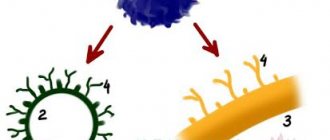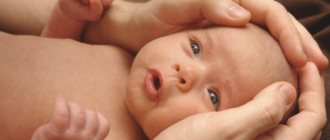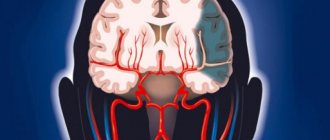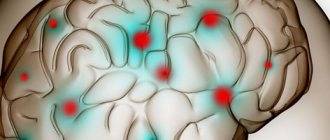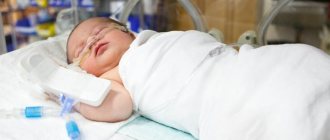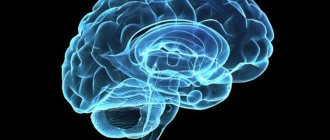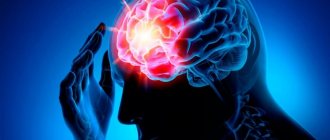The prevalence of lesions of the nervous system (CNS) in newborns has recently become almost epidemic. More and more children under one year of age are turning to pediatric neurologists and pediatricians with complaints of hyperactivity and developmental delay, which are nothing more than the consequences of pathology suffered during childbirth.
Many diseases of older children occur due to the fact that damage to the nervous system during the neonatal period was not recognized in time. In 80-85% of dead newborns, the section reveals a spinal cord injury; brain injuries are 2 times less common.
The consequences of damage to the nervous system during childbirth can be hydrocephalus, developmental delay, paresis and paralysis, visual and hearing impairment.
Modern views
Perinatal damage to the central nervous system is a complex of organic and/or functional damage to the central nervous system of the fetus in the prenatal period from the 26th week or of the newborn to 7 days, which manifests itself in the first hours, days, months of the child’s life.
Damage to the central nervous system in a child is the main cause of the development of movement disorders, hypertensive-hydrocephalic syndrome, hyperexcitability or depression syndrome, as well as the syndrome of vegetative-visceral disorders.
The diagnosis of PPCNSL in a child is usually made in the maternity hospital and requires correction.
This diagnosis of PPCNSL in children is applicable up to the age of 1 year. Damage to the central nervous system in newborns is a reason to establish the cause, diagnostic tactics and treatment of this problem. Underestimation of the state of PCPNS in a newborn can provoke the development of neuropsychic, motor and visceral disorders.
Severe cerebrovascular accidents, trauma, ischemia or intracranial hemorrhage can pose a great threat to the child's life.
Main complaints
Pathology of the nervous system in newborns does not appear immediately, and this is its insidiousness. After all, the longer the disease remains unrecognized, the more difficult it is to treat it in the future. Only very pronounced disorders make themselves felt in the first days of the baby’s life, usually manifesting themselves in convulsions. Seizures that occur in the first 24 hours after the baby is born are especially dangerous.
Most often, parents pay attention to the child’s hyperexcitability, restless behavior, and sleep disturbances. Also often associated symptoms are excessive regurgitation and choking. Some mothers manage to notice disturbances in motor functions. As a simple home test, you can use a child's skills screening test depending on age.
Screening test. Normal full-term baby:
- By 2 months he can hold his head while lying on his stomach.
- By 6 months, sits independently and steadily.
- At 12 months – the beginning of independent walking.
Children with traumatic lesions of the spinal cord at the neck level are delayed by 1-2 months, however, their developmental delay is not as severe as with damage to the cerebral cortex.
Based on the pace at which the child develops, one can approximately judge the presence of neurological abnormalities and consult a doctor in time. The doctor will conduct more detailed studies that will show the diagnosis and level of damage to the nervous system.
Reasons for development
Perinatal damage to the central nervous system may have a number of main reasons for its development:
Diseases of the mother with symptoms of chronic or acute intoxication;
Acute inflammatory or infectious diseases, as well as exacerbation of chronic foci of infection during pregnancy;
Nutritional (nutritional) disorders of the mother during pregnancy, insufficient or irrational nutrition;
Hereditary diseases of the mother associated with disorders of blood flow, blood vessels, autoimmune diseases;
Metabolic diseases;
Young or old age of the pregnant woman (under 18 or over 35 years);
Severe pregnancy with symptoms of toxicosis, threat of miscarriage or bleeding in the anamnesis, poisoning with poisons, metals, as well as disruption of utero-fetal-placental blood flow, preeclampsia or eclampsia, polyhydramnios;
Labor disruption: rapid or prolonged labor. Childbirth with a large fetus, multiple pregnancy, weakness of labor, clinically or anatomically narrow pelvis;
Immaturity and/or prematurity of the fetus;
Congenital malformations of newborn systems;
Damage to the central nervous system in a newborn can have causes such as intoxication, infections, poisoning, and most importantly, developmental defects and hereditary predisposition. Damage to the central nervous system in a child may be a consequence of trauma during pregnancy or childbirth. A long anhydrous interval, discoordinated labor, cesarean section, entanglement of the fetus with the umbilical cord are also causes of the condition - perinatal damage to the central nervous system.
The consequences of this syndrome can be expressed during the neonatal period, infancy and in older children.
Development of the central nervous system and signs of pathology
- home
- Archive
- Archive of articles
- Baby
- Development of the central nervous system and signs of pathology
Perinatal damage to the nervous system is precisely this diagnosis that is increasingly being made to newborn babies. Behind these words lies a fairly large group of various lesions of the brain and spinal cord that occur during pregnancy and birth of a baby, as well as in the first days of his life. Periods of the disease During this disease, despite the variety of causes that cause it, it is customary to distinguish three periods: acute (1st month of life), recovery, which is divided into early (from the 2nd to 3rd months of life) and late (from 4 months to 1 year in full-term infants, up to 2 years in premature infants), and the outcome of the disease. In each of these periods, perinatal injuries have different clinical manifestations - syndromes, and several of them may be present simultaneously in one child. The severity of each syndrome and their combination make it possible to determine the severity of damage to the nervous system, prescribe the correct treatment and predict the further development of the disease. Acute period syndromes Acute period syndromes include comatose, convulsive, hypertensive-hydrocephalic syndromes, as well as central nervous system depression and increased neuro-reflex excitability. With mild damage to the central nervous system in newborns, a syndrome of increased neuro-reflex excitability is most often observed, which is manifested by shuddering, increased (hypertonicity) or decreased (hypotonic) muscle tone, increased reflexes, tremor (trembling) of the chin and limbs, restless shallow sleep, frequent causeless crying . With moderate damage to the central nervous system in the first days of life, depression of the central nervous system occurs in the form of decreased motor activity and muscle tone, weakened reflexes of newborns, including sucking and swallowing. By the end of the 1st month of life, depression of the central nervous system gradually disappears, and in some children it is replaced by increased arousal. With an average degree of damage to the central nervous system, disturbances in the functioning of internal organs and systems are observed (vegetative-visceral syndrome). Due to imperfect regulation of vascular tone, uneven coloration (marbling) of the skin appears. In addition, there are disturbances in the rhythm of breathing and heart contractions and dysfunction of the gastrointestinal tract in the form of unstable stools, constipation, frequent regurgitation, and flatulence. Often, children in the acute period of the disease show signs of hypertensive-hydrocephalic syndrome, which is characterized by excessive accumulation of fluid in the spaces of the brain containing cerebrospinal fluid, which leads to increased intracranial pressure. The main symptoms that can be noticed not only by doctors, but also by parents are the rapid growth rate of the child’s head circumference (more than 1 cm per week), significant size and bulging of the large fontanelle, divergence of cranial sutures, restlessness, frequent regurgitation, unusual eye movements (nystagmus). ). A sharp depression of the activity of the central nervous system and other organs and systems is inherent in the extremely serious condition of a newborn with the development of coma syndrome (lack of consciousness and coordinating function of the brain). This condition requires emergency care in intensive care. Syndromes of the recovery period During the recovery period, parents should be alert to poor facial expressions, late appearance of a smile, decreased interest in toys and environmental objects, as well as a weak monotonous cry, delayed appearance of humming and babbling. Perhaps all this is a consequence of lesions of the central nervous system, in which, along with others, syndromes of motor disorders and delayed psychomotor development occur. Outcomes of the disease By the age of one year, in most children, manifestations of perinatal lesions of the central nervous system gradually disappear. Frequent consequences of perinatal lesions include: • delayed mental, motor or speech development; • cerebroasthenic syndrome (mood swings, motor restlessness, anxious sleep, weather dependence); • attention deficit hyperactivity disorder: aggressiveness, impulsivity, difficulty concentrating and maintaining attention, learning and memory disorders. The most unfavorable outcomes are epilepsy, hydrocephalus, and cerebral palsy, indicating severe perinatal damage to the central nervous system. Causes of disturbances in the functioning of the central nervous system Experts distinguish four groups of perinatal lesions of the central nervous system: 1) hypoxic, in which the main damaging factor is hypoxia (lack of oxygen); 2) traumatic, resulting from mechanical damage to the tissues of the brain and spinal cord during childbirth in the first minutes and hours of the child’s life; 3) dismetabolic and toxic-metabolic, the main damaging factor of which is metabolic disorders in the child’s body, as well as damage resulting from the use of toxic substances by a pregnant woman (medicines, alcohol, drugs, smoking); 4) damage to the central nervous system during infectious diseases of the perinatal period, when the main damaging effect is exerted by an infectious agent (viruses, bacteria and other microorganisms). Help for children with central nervous system damage Infants with central nervous system damage need treatment and rehabilitation as early as possible, since in the first months of a child’s life many of the disorders are reversible without serious consequences. It is during this period that the regenerative abilities of the child’s body are especially great: it is still possible for the nerve cells of the brain to mature to replace those lost after hypoxia, and for the formation of new connections between them, which will be responsible for the normal development of the baby. First aid is provided to babies in the maternity hospital. This stage includes restoration and maintenance of vital organs (heart, lungs, kidneys), normalization of metabolic processes, treatment of central nervous system damage syndromes (depression or excitation, seizures, cerebral edema, increased intracranial pressure). The basis of treatment is medication and intensive therapy. During treatment, the child's condition gradually improves, however, many symptoms of central nervous system damage may persist, which requires transfer to the pathology department of newborns and premature infants or to the neurological department of a children's hospital. At the second stage of treatment, drugs are prescribed aimed at eliminating the cause of the disease (infections, toxic substances) and affecting the mechanism of development of the disease, as well as drugs that stimulate the maturation of brain tissue, reduce muscle tone, improve the nutrition of nerve cells, cerebral circulation and microcirculation. In addition to drug therapy, when the condition improves, a course of massage with the gradual addition of therapeutic exercises, electrophoresis sessions and other rehabilitation methods are prescribed (for full-term infants - from the end of the 3rd week of life, for premature infants - a little later). After completing the course of treatment, most children are discharged home with recommendations for further observation in a children's clinic (third stage of rehabilitation). The pediatrician, together with a neurologist, and, if necessary, with other specialized specialists (ophthalmologist, otolaryngologist, orthopedist, psychologist, physiotherapist), draws up an individual plan for managing the child in the first year of life. During this period, non-drug rehabilitation methods are most often used: massage, therapeutic exercises, electrophoresis, pulsed currents, acupuncture, thermal procedures, balneotherapy (therapeutic baths), swimming, as well as psychological and pedagogical correction aimed at developing the baby’s motor skills, speech and psyche. Parents whose baby was born with signs of a central nervous system disorder should not despair. Yes, you will have to put in much more effort than other moms and dads, but in the end they will pay off, and the reward for this work will be the happy smile of the little man.
Prognosis and outcomes
The diagnosis of central nervous system damage or the diagnosis of PPCNSL in a child occurs in 85% of newborns.
Motor disorders may occur, for example, motor excitability or depression syndrome, which significantly aggravates the child’s condition and disrupts his further adaptation in society.
Damage to the central nervous system in a newborn can cause the development of hyperexcitability in a child with a disorder of attention, memory and development of basic skills - speech, writing and reading.
Damage to the central nervous system in a child can have different outcomes:
complete recovery, mental retardation, minimal brain dysfunction, nervousness, epilepsy, hydrocephalus, cerebral palsy, vegetative-visceral disorder syndrome.
In older children, a child's adaptation disorder, memory and attention disorders, high distractibility and mental fatigue develop.
PPCNSL in newborns can cause the development of dysfunction of the gastrointestinal tract and cardiovascular system.
CNS depression syndrome
This syndrome is characterized by a weak reaction of the newborn to the environment, general lethargy. Other symptoms of central nervous system depression include depressed reflexes, a sharp decrease in spontaneous motor activity, and severe muscle hypotonia.
Today, experts distinguish 4 main degrees of central nervous system depression:
- Lethargy. At this stage, the child is practically constantly in a state of sleep. He can be awakened by external stimuli, but if left alone he quickly falls asleep again;
- Stunned. In this state, the child reacts to tactile stimulation only with a frown or a short-term grimace, as well as weak movements in the limbs. Upon examination, the grasping reflex is evoked, but all other reflexes are absent.
- Stupor. The child reacts very weakly to irritations, and only to painful ones. The rest of the clinical picture is similar to the state of stupor.
- Coma. The child has no reaction to painful stimuli at all. In coma I, the newborn retains brainstem level reflexes and some other reactions to external stimuli. In coma II, some of the brainstem level reflexes disappear, and in coma III they disappear completely. It is worth noting that in most cases, the absence of brainstem level reflexes indicates severe brain damage. This assumes an unfavorable prognosis. The absence of reflexes at the moments of recovery from a comatose state also indicates the presence of persistent neurological disorders.
Clinical Brain Institute Rating: 5/5 — 1 votes
Share article on social networks
Treatment of PCNSL
Treatment of AEDs in newborns should be early and aimed at correcting existing conditions.
The diagnosis of PPCNSL in a child should cause special attention not only from the pediatrician and other specialists, but also from parents.
PEP in newborns is an indication for early prescription of physical therapy methods. Non-drug methods of therapy for PPCNSL in newborns are the main ones. Massage and physiotherapy are the golden “pill” in the treatment of PEP in newborns.
The diagnosis of central nervous system damage is not a death sentence; it can be corrected quite well with modern methods of physiotherapy.
Osteopathic examination
An examination by an osteopathic doctor involves not only a neurological examination, but also a search for anatomical abnormalities in the structure of the skull, cervical vertebrae, sacrum, ribs, etc. All this is of great importance for the child’s health, since the slightest deviations in anatomy are projected on an enlarged scale into the future life of the baby. Osteopathic diagnosis is carried out by a doctor and includes:
- Examination: determination of the arch of the body, position of the limbs, behavior of the child.
- Assessing the amplitude, strength and rhythm of the primary respiratory mechanism.
- Assessment of the pattern of the craniosacral system.
- Testing the mobility of the cervical and lumbosacral spine.
- Global skull test, assessing the mobility of each of the bones of the arch and base.
- Diagnosis of intraosseous injuries of the skull and sacrum.
After the examination, the osteopathic doctor gets an idea of all the anatomical disorders in the child’s body and immediately begins treatment.
Treatment
In the acute period of severe perinatal brain damage, treatment is carried out in the neonatal intensive care unit. First of all, disturbances in the functioning of the respiratory, cardiovascular system and metabolic disorders are eliminated, seizures are eliminated (if necessary, artificial ventilation of the lungs, intravenous infusions, and parenteral nutrition are performed). Next, the newborns are transferred to a special department, where individual treatment is continued depending on the nature and severity of the brain damage: anticonvulsants are used, in case of developing hydrocephalus - dehydration drugs, as well as drugs that stimulate the growth of capillaries and improve the nutrition of damaged brain tissue. These same drugs, as prescribed by a neurologist, can be used throughout the first year of life in repeated courses. For moderate and especially mild lesions of the central nervous system, non-drug therapy is mainly used. In the recovery period (from the end of the first year of life), non-drug rehabilitation methods are of decisive importance: therapeutic massage and gymnastics, exercises in water, physiotherapy, pedagogical methods of music therapy (healing and treating the body with the help of music).
